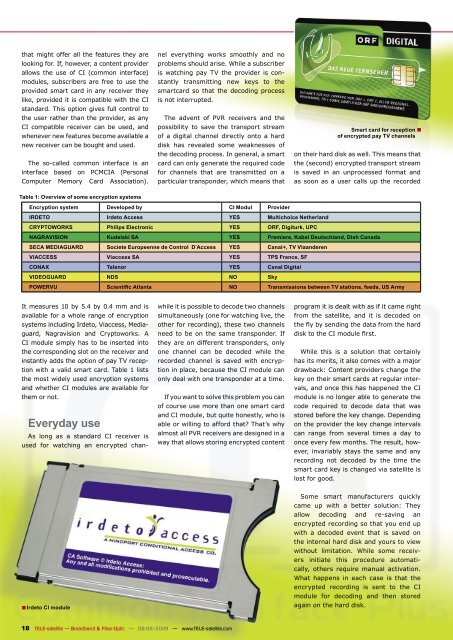08-09 - TELE-satellite International Magazine
08-09 - TELE-satellite International Magazine
08-09 - TELE-satellite International Magazine
You also want an ePaper? Increase the reach of your titles
YUMPU automatically turns print PDFs into web optimized ePapers that Google loves.
that might offer all the features they are<br />
looking for. If, however, a content provider<br />
allows the use of CI (common interface)<br />
modules, subscribers are free to use the<br />
provided smart card in any receiver they<br />
like, provided it is compatible with the CI<br />
standard. This option gives full control to<br />
the user rather than the provider, as any<br />
CI compatible receiver can be used, and<br />
whenever new features become available a<br />
new receiver can be bought and used.<br />
The so-called common interface is an<br />
interface based on PCMCIA (Personal<br />
Computer Memory Card Association).<br />
Table 1: Overview of some encryption systems<br />
It measures 10 by 5.4 by 0.4 mm and is<br />
available for a whole range of encryption<br />
systems including Irdeto, Viaccess, Mediaguard,<br />
Nagravision and Cryptoworks. A<br />
CI module simply has to be inserted into<br />
the corresponding slot on the receiver and<br />
instantly adds the option of pay TV reception<br />
with a valid smart card. Table 1 lists<br />
the most widely used encryption systems<br />
and whether CI modules are available for<br />
them or not.<br />
■<br />
Everyday use<br />
As long as a standard CI receiver is<br />
used for watching an encrypted chan-<br />
Irdeto CI module<br />
nel everything works smoothly and no<br />
problems should arise. While a subscriber<br />
is watching pay TV the provider is constantly<br />
transmitting new keys to the<br />
smartcard so that the decoding process<br />
is not interrupted.<br />
The advent of PVR receivers and the<br />
possibility to save the transport stream<br />
of a digital channel directly onto a hard<br />
disk has revealed some weaknesses of<br />
the decoding process. In general, a smart<br />
card can only generate the required code<br />
for channels that are transmitted on a<br />
particular transponder, which means that<br />
while it is possible to decode two channels<br />
simultaneously (one for watching live, the<br />
other for recording), these two channels<br />
need to be on the same transponder. If<br />
they are on different transponders, only<br />
one channel can be decoded while the<br />
recorded channel is saved with encryption<br />
in place, because the CI module can<br />
only deal with one transponder at a time.<br />
If you want to solve this problem you can<br />
of course use more than one smart card<br />
and CI module, but quite honestly, who is<br />
able or willing to afford that? That’s why<br />
almost all PVR receivers are designed in a<br />
way that allows storing encrypted content<br />
18 <strong>TELE</strong>-<strong>satellite</strong> — Broadband & Fiber-Optic — <strong>08</strong>-<strong>09</strong>/20<strong>09</strong> — www.<strong>TELE</strong>-<strong>satellite</strong>.com<br />
Smart card for reception<br />
of encrypted pay TV channels<br />
on their hard disk as well. This means that<br />
the (second) encrypted transport stream<br />
is saved in an unprocessed format and<br />
as soon as a user calls up the recorded<br />
Encryption system Developed by CI Modul Provider<br />
IRDETO Irdeto Access YES Multichoice Netherland<br />
CRYPTOWORKS Philips Electronic YES ORF, Digiturk, UPC<br />
NAGRAVISION Kudelski SA YES Premiere, Kabel Deutschland, Dish Canada<br />
SECA MEDIAGUARD Societe Europeenne de Control D`Access YES Canal+, TV Vlaanderen<br />
VIACCESS Viaccess SA YES TPS France, SF<br />
CONAX Telenor YES Canal Digital<br />
VIDEOGUARD NDS NO Sky<br />
POWERVU Scientific Atlanta NO Transmissions between TV stations, feeds, US Army<br />
program it is dealt with as if it came right<br />
from the <strong>satellite</strong>, and it is decoded on<br />
the fly by sending the data from the hard<br />
disk to the CI module first.<br />
While this is a solution that certainly<br />
has its merits, it also comes with a major<br />
drawback: Content providers change the<br />
key on their smart cards at regular intervals,<br />
and once this has happened the CI<br />
module is no longer able to generate the<br />
code required to decode data that was<br />
stored before the key change. Depending<br />
on the provider the key change intervals<br />
can range from several times a day to<br />
once every few months. The result, however,<br />
invariably stays the same and any<br />
recording not decoded by the time the<br />
smart card key is changed via <strong>satellite</strong> is<br />
lost for good.<br />
Some smart manufacturers quickly<br />
came up with a better solution: They<br />
allow decoding and re-saving an<br />
encrypted recording so that you end up<br />
with a decoded event that is saved on<br />
the internal hard disk and yours to view<br />
without limitation. While some receivers<br />
initiate this procedure automatically,<br />
others require manual activation.<br />
What happens in each case is that the<br />
encrypted recording is sent to the CI<br />
module for decoding and then stored<br />
again on the hard disk.<br />
■

















